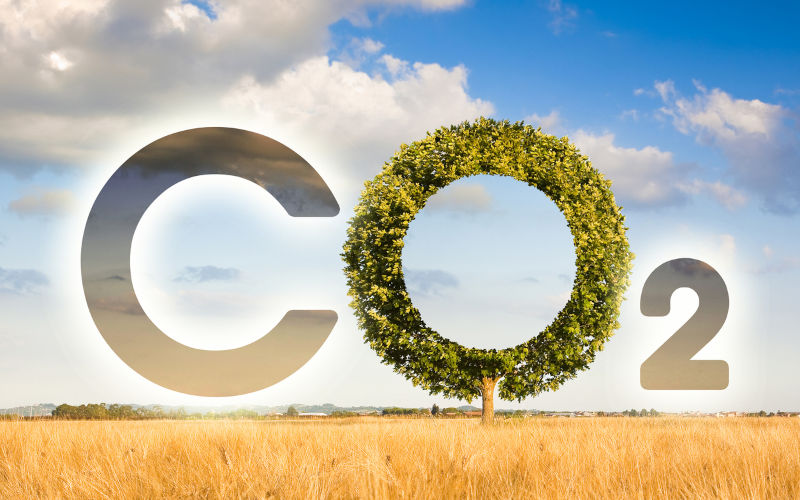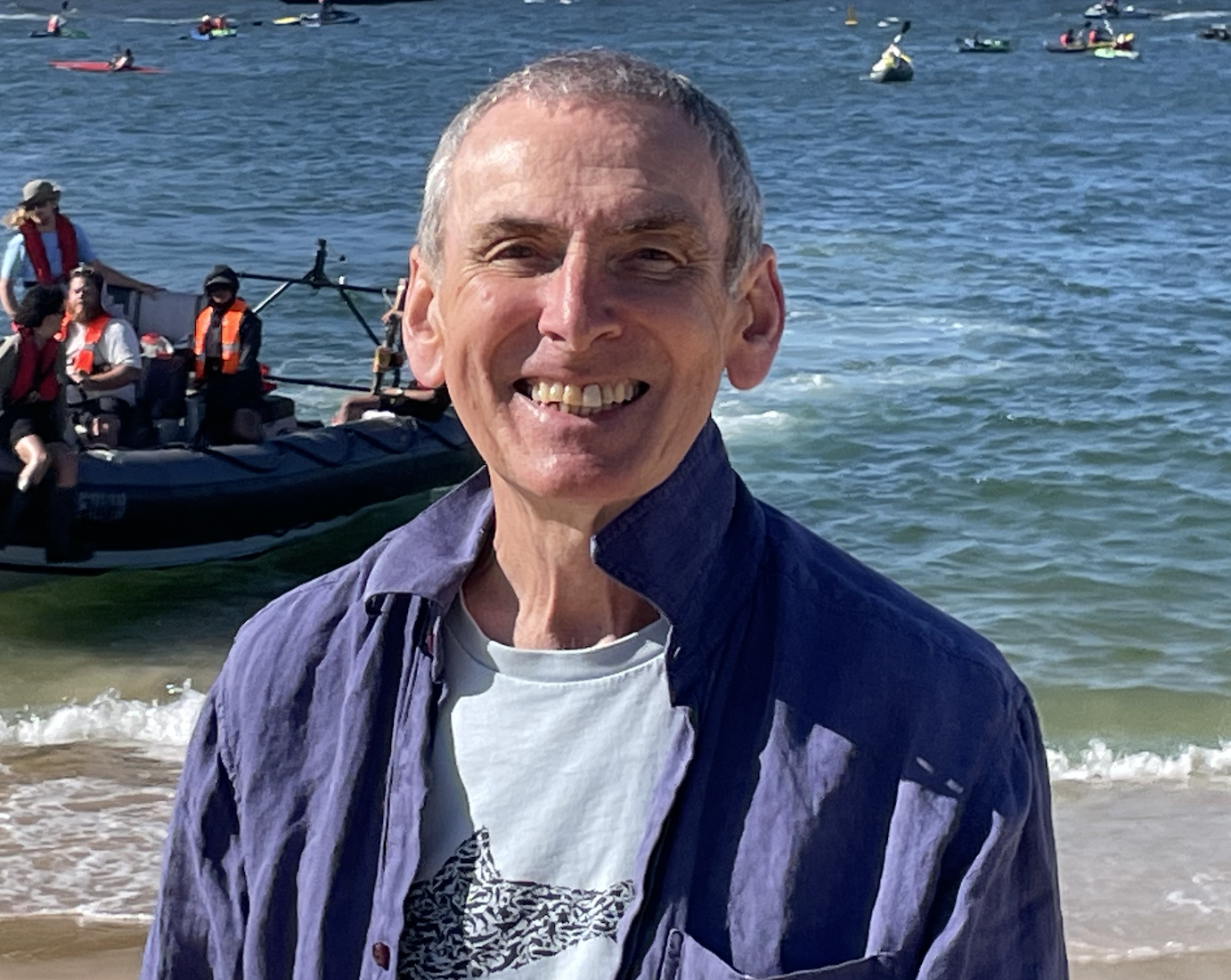Environment: 2023 - increased GHG emissions, increased atmospheric GHG levels and record high temperatures
December 24, 2023
Despite what we have we seen and learnt during 2023, the COP meeting failed again to take strong action on fossil fuels. Is nature for nature or only for humans?
COP out on phase out again
The demand from climate activists at the recent COP28 meeting in Dubai was for a ‘Fast, Fair, Full, Funded Fossil Fuel Phase Out’, with the optional ‘Feminist’ and ‘Forever’.
From all the backslapping, grins, hyperbole and headlines (‘ Two Words That Could Change the World’, ‘ Agreement Signals “Beginning of the End” of the Fossil Fuel Era’, ‘ Transition Out of Fossil Fuels, Dawn of Renewables’), you might have concluded that the nations at the COP had actually greed to stop burning all fossil fuels by Christmas. If so, the joke was on you, Ho, Ho, Ho.
The reason for the overblown celebrations was that after 30 years and 28 COPs, the words ‘fossil fuels’ finally made it into a COP closing statement. Turn on the Christmas lights, Rudolph.
The reality is that the relevant clause (28, by an odd coincidence, if you want to go searching) simply ‘calls’ on countries to ‘contribute’ to global efforts to ‘t__ransition away from fossil fuels in energy systems’, in whatever way each sees fit, There are no promises, pledges or commitments here. No targets. No time frames.
The wording is about as weak as it could be without ‘fossil fuels’ being absent altogether. But the necessity of presenting the previous two weeks as a success drove a linguistic compromise between most COP members who accept the science and are feeling increasing public pressure to commit to phasing out fossil fuels and the far fewer major coal, oil and gas producing nations that want to direct attention to reducing emissions rather than any mention of fossil fuels, let alone linked to the dreaded words ‘phase out’.
There is, however, one other important group who are opposed to any rapid phase out of fossil fuels: those developing nations that have and want to develop their own fossil fuels and/or that see fossil fuels as the only viable energy source for their economic development. This not unreasonable position is well illustrated by Ruth Nankabirwa, Uganda’s Minister of Energy and Mineral Development:
‘To tell us to stop fossil fuels is an insult. It’s like you are telling Uganda to stay in poverty. We could accept a long-term phase out, if it made clear that developing nations can exploit their resources in the near term, while wealthy long-time producers quit first.’ And provide technological and financial assistance to help the poorer nations leapfrog the fossil fuel era.
Ebony Bennett, the Deputy Director of The Australia Institute, characterises COP28 as a ‘ _dystopian satire_ – if you scripted it, it wouldn’t be believable’. Her excellent summary of the roles played by the hosts and Australia is well worth reading.
All that said, I would rather have the whole UNFCCC-COP process grinding along year after year than see it fall apart. Somewhat like Christmas, really, for an old cynic.
Sentimental or humanistic environmentalism
‘Saving nature, but only for man’ is the title of an essay in Time in 1991 by Charles Krauthammer, a successful political columnist and broadcaster in the USA for over thirty years:
I like the caribou as much as the next man. And I would be rather sorry if their mating patterns are disturbed (as a result of oil drilling in the Alaska National Wildlife Refuge). But you can’t have everything. And if the choice is between the welfare of caribou and reducing an oil dependency that gets people killed in wars, I choose man over caribou every time.
Similarly, the spotted owl. I am no enemy of the owl. If it could be preserved at no or little cost, I would agree: the variety of nature is a good, a high aesthetic good. But it is no more than that. And sometimes aesthetic goods have to be sacrificed to the more fundamental ones. If the cost of preserving the spotted owl is the loss of livelihood for 30,000 logging families, I choose family over owl.
The important distinction is between those environmental goods that are fundamental and those that are merely aesthetic. Nature is our ward. It is not our master. It is to be respected and even cultivated. But it is man’s world. And when man has to choose between his well-being and that of nature, nature will have to accommodate.
Man should accommodate only when his fate and that of nature are inextricably bound up. The most urgent accommodation must be made when the very integrity of man’s habitat – e.g., atmospheric ozone – is threatened. When the threat to man is of a lesser order (say, the pollutants from coal- and oil-fired generators that cause death from disease but not fatal damage to the ecosystem), a more modulated accommodation that balances economic against health concerns is in order. But in either case the principle is the same: protect the environment – because it is man’s environment.
The sentimental environmentalists will call this saving nature with a totally wrong frame of mind. Exactly. A sane – a humanistic – environmentalism does it not for nature’s sake but for our own.
On first reading, I was alarmed by Krauthammer’s anthropocentric assertions that it is man’s world and man’s environment, that our wellbeing is more important than nature’s, that nature must accommodate man’s wishes, and that biodiversity is no more than an aesthetic good.
On reflection, however, I imagine that similar views were pretty common in 1991, before the general public developed a basic understanding of fossil fuels, greenhouse gas emissions, climate change, loss of biodiversity, complex adaptive systems, etc. Indeed, such views are probably still quite common in 2023, especially that nature should be protected only when humanity’s survival depends on it and most definitely not when it might damage my personal interests.
Being realistic, even in an environmentally sustainable world, if ever we get there, with 8-10 billion people it will still be necessary to make some decisions that involve damage to nature.
In 2008 and again in 2014, Krauthammer wrote: ‘I’m not a global warming believer. I’m not a global warming denier. I’m a global warming agnostic who believes instinctively that it can’t be very good to pump lots of CO2 into the atmosphere but is equally convinced that those who presume to know exactly where that leads are talking through their hats’.
One can’t help feeling that if Krauthammer was espousing these views as recently as 2014 (he died in 2018), he hadn’t been keeping up with the science. And the problem with ignoring projections is that it leads to a strategy of inaction, which is fine if the worst that can happen is that the Arctic gets an extra 2mm of snow a year. Not so good if there’s a 50% chance of runaway global warming leading to Hothouse Earth.
Emissions keep rising
The World Meteorological Organization’s November 2023 Greenhouse Gas Bulletin confirms what anyone who’s been paying attention knows: ever more greenhouse gases (GHGs) are being pumped into the atmosphere, the concentration of GHGs in the atmosphere continues to increase and the rate of increasing concentration in absolute terms (parts per million per year) is more rapid now than 30 years ago (first three graphs below). None of this is surprising but it does dispel any hope that although things may be getting worse, at least it’s more slowly now.
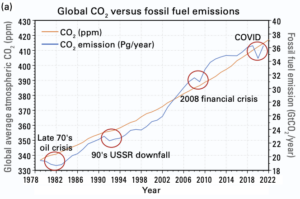
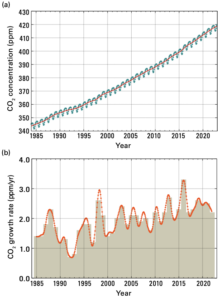
The bottom line (next graph) is that the global warming effect of the GHGs in the atmosphere has increased by 50% in the last three decades, four-fifths of that due to the increase in CO2 in the atmosphere.
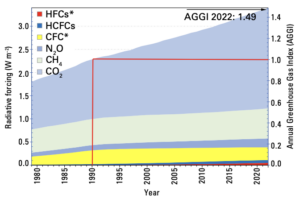
The final graph displays the relative contributions in 2022 of the various GHGs to global warming since the pre-industrial era. CO2 has contributed almost two-thirds and methane almost a fifth. Most of the anthropogenic CO2 comes from fossil fuels but most of the anthropogenic methane comes from agriculture. The various (relatively modern) fluorocarbons, that have very strong global warming effects, have now contributed over 10%.

The WMO highlights four challenges in assessing the drivers of climate change:
- The many feedback loops in the Earth’s climate system – for instance, the carbon emissions from soils increase and the carbon uptake by oceans and forests decreases as the climate warms.
- The tipping points or critical thresholds that appear in the Earth’s climate systems when an incremental change triggers an accelerating and irreversible environmental event – for instance, rapid die-back in the Amazon and collapse of large ice sheets.
- Natural variability in the atmospheric concentrations of CO2, methane and nitrous oxide - for instance, during the El Nino-La Nina cycle.
- The unique emission trends, global warming potential and atmospheric lifetimes of each of the GHGs other than CO2.
The WMO argues that ‘these uncertainties must not deter action. Rather, they underscore the need for flexible, adaptive strategies and the importance of risk management in the path to net-zero.’
10 insights from 2023
What else has climate science told us during 2023?
- Exceeding 1.5oC of global warming is all but inevitable. Keeping the overshoot as low and short as possible is essential.
- Fossil fuel use must be rapidly phased out to keep the Paris Agreement alive.
- Natural carbon sinks on the land and in the oceans cannot remove enough carbon dioxide from the atmosphere to correct the overshoot.
- Robust policies are needed to develop and implement the carbon dioxide removal technologies that will also be necessary to correct the overshoot.
- The climate and biodiversity emergencies must be managed together.
- Simultaneous and sequential climate disasters produce amplified impacts on the environment and humans (1 + 1 = 3 not 2).

- Mountain glacier loss is accelerating.
- People facing climate risks may be unable or unwilling to relocate.
- Climate justice must be part of climate adaptation.
- Just and equitable climate action requires reformed food systems.
This is more of a reinforcement of the knowledge we had twelve months ago than ten gobsmacking revelations. It’s valuable, nonetheless.
Happy Holiday Season
Whatever your orientation to existence, I hope that you have a healthy, peaceful and enjoyable next few weeks. I’m going to take a four-week break and will reappear in your inboxes on January 28th.
My Christmas gift to you all is this truly charming duet between Kermit and Debbie Harry singing the ‘Rainbow Connection’.
The Illawarra flame tree is native to the east coast from Cape York to southern NSW.

